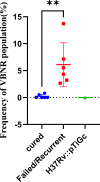Assessing the propensity of TB clinical isolates to form viable but non-replicating subpopulations
- PMID: 39532967
- PMCID: PMC11557868
- DOI: 10.1038/s41598-024-79389-w
Assessing the propensity of TB clinical isolates to form viable but non-replicating subpopulations
Erratum in
-
Correction: Assessing the propensity of TB clinical isolates to form viable but non-replicating subpopulations.Sci Rep. 2025 Sep 11;15(1):32415. doi: 10.1038/s41598-025-19393-w. Sci Rep. 2025. PMID: 40935828 Free PMC article. No abstract available.
Abstract
Current tuberculosis (TB) treatment is typically effective against drug-susceptible Mycobacterium tuberculosis, but can fail due to acquired drug resistance or phenotypic resistance. M. tuberculosis persisters, a subpopulation of viable but non-replicating (VBNR) antibiotic-tolerant bacteria, are thought to contribute to poor TB treatment outcomes. In this exploratory study, we investigated treatment-naïve drug-susceptible clinical isolates collected from people with TB, who subsequently had unsuccessful treatment outcomes. These were compared to isolates from cured individuals in terms of their ability to form VBNR subpopulations. Clinical isolates from individuals with unfavorable treatment outcomes form larger subpopulations of VBNR M. tuberculosis (2.67-13.71%) than clinical isolates from cured cases (0- 1.63%) following infection of THP-1 macrophages. All isolates were drug susceptible based on phenotypic and genotypic analysis. Whole genome sequencing identified 23 non-synonymous genomic variants shared by treatment failure clinical isolates, that were not present in isolates from cured cases. This exploratory study highlights the ability of treatment-naïve clinical isolates to form heterogeneous populations containing VBNR M. tuberculosis. We also demonstrate that clinical isolates from individuals with unsuccessful treatment outcomes form higher percentages of VBNR M. tuberculosis. The findings of this exploratory study suggest that an increased propensity to form VBNR subpopulations may impact TB treatment outcome.
Keywords: Heterogenous; Persistence; Persister; TB; Treatment failure; Tuberculosis; VBNR.
© 2024. The Author(s).
Conflict of interest statement
Figures



References
MeSH terms
Substances
Grants and funding
LinkOut - more resources
Full Text Sources
Medical

